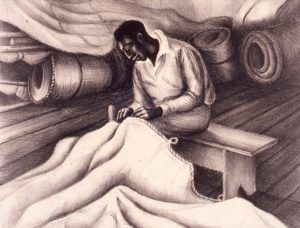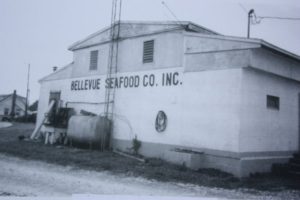
Waterman tonging off of the Enniskillen estate on the Tred Avon River near Oxford, Maryland. Photo from the Hollyday Collection 1938.
Due to its proximity to the Chesapeake Bay, the Atlantic Ocean, and many creeks, rivers, and other bodies of water, seafood and the industries surrounding it has always been an important aspect of life in Talbot County. These industries have shaped the culture of the area, providing jobs, influencing recipes, transportation, and industrialization.
Even during the earliest years of settlement in America, Black people worked as sailors, shipbuilders, and oyster harvesters. Working on the bay was one of the most guaranteed ways of earning money, and was open to people regardless of race. It is estimated that at the height of the skipjacks’ popularity that at least 1 in 10 boats had a black captain. Black watermen were given “Seaman’s Protection Certificates” which identified them as American citizens, making them the first black American citizens. These men were often called “Black Jacks.” This gave them a level of security that was uncommon in jobs at the time.

Two girls standing with nets in the water. 1910-1919.
In 1836 a bill was passed that prevented black sailors from owning a boat large enough to be registered. This law, along with other societal discriminations meant that during this time very few black men were the captains of their own vessels. Many white watermen, having worked with black watermen under harsh conditions and difficult work, respected them and their work and continued to employ workers on their boats regardless of race.
After the Civil War, and after emancipation, many formerly enslaved people began working on the water. The idea of a job that was completely independent was very appealing, as it gave people a level of control and freedom they had not previously experienced.
In order for watermen to be able to work the water, they needed people to make the boats, sails, and other harvesting tools. The making of tools for watermen was a powerful industry itself. One of the most well known craftsmen was Downes Curtis, a sailmaker from Oxford, MD.

A painting depicting sailmaker Downes Curtis by artist Ruth Starr Rose.
Another important part of the seafood industry is the processing of the catch. This includes picking crabs, shucking oysters, or breaking down fish. African-American inhabitants of the Eastern shore also worked in these businesses.

At Tilghman Packing Company the watermen would bring their catch directly to the packing houses where they would be off loaded and put directly into large stainless steel steamers to be cooked by steaming. The cage seen here held 15 bushels of crabs. The crabs would then be cooled prior to picking so the meat would stay intact. Hollyday c. 1952
Once the seafood was processed, it would be packed into containers and shipped out to stores and restaurants to be eaten. The packing and canning plants were also a place that employed many black workers.

Mr. & Mrs. Fred S. Jewett of Coulbourne & Jewett Seafood Packing Company. Photo from Hollyday Collection.
One packing plant in Talbot County was The Coulbourne and Jewett Seafood Packing Company, located in St. Michaels, MD. It was owned by African American business partners William Coulbourne and Frederick Jewett. The company operated from 1902-1962 and was located on Navy Point, now the site of the Chesapeake Bay Maritime Museum. Initially the business cut, packaged and shipped fish. Over time they moved to the sales of crab and crab meat, shipping the delicacy all over the country. Fred Jewett is known for his method of grading crab meat; back fin, claw, lump, special and regular. This method is still used today.

The exterior of Bellevue Seafood Company, Inc. This image was loaned to us by Col. William DeShields, a member of a long time Bellevue family, for our permanent African American Exhibit.
Another Black owned seafood company was Bellevue Seafood Company. It was founded by Samuel Turner who was descended from a family of African-American waterman and entrepreneurs in the seafood packing industry. The company plant was built in 1966 in Bellevue Maryland. They processed oysters, blue crabs and soft shell clams.
Between working the water, manufacturing equipment, processing the catch, packing food, and creating dishes using crabs and other seafood, African American inhabitants of Talbot County have always been involved in the seafood industry, and have contributed to the culture surrounding it.
Further Reading
Books
- Black Jacks: African American Seamen in the Age of Sail by W. Jeffrey Bolster. (Cambridge,
Massachusetts: Harvard University Press, 1997.) - The Chesapeake Bay Through Ebony Eyes by V. O. Leggett. (Maryland: Bay Media. Blacks of the
Chesapeake Foundation, 1999.)
Online Articles and Websites
- Bellevue Seafood Packing Company
- Architectural survey file and information on the company from the Maryland Historic Trust.
- Black Men, Blue Waters: African Americans on the Chesapeake
- Article by Harold Anderson, featured in the Feb-Mar 1998 “Marine Notes” by the Maryland Sea Grant
- Black watermen sail into view; History: Amateur researchers delve into libraries and family attics to find ‘unsung heroes’ of the Chesapeake Bay.
- 1999 Baltimore Sun article by Heather Dewar on the opening of 2 museum exhibits surrounding African-American watermen.
- The Chesapeake Bay through Ebony Eyes. Curriculum Guide.
- A curriculum guide to teach the book “The Chesapeake Bay through Ebony Eyes” to a classroom.
-
Discover Delmarva: Downes Curtis -Mastor Sailmaker
- A 2019 WMTD article by Erica Murphy on sailmaker Downes Curtis
- Life on the Bay, through ebony eyes
- Chesapeake Bay Program article by Darius Stanton
- Menhaden Chanteys: An African American Maritime Legacy
- Article by Harold Anderson, featured in Vol. 18 of “Marine Notes” by the Maryland Sea Grant
- W. A. Turner & Sons
- Architectural Survey File and information on another Black owned seafood company by the Maryland Historic Trust
- Waters of Despair, Waters of Hope
- Site from the Mariners Museum on African Americans on the Chesapeake Bay.
Videos
-
Black Captains of the Chesapeake – Promo
- Promotional video for the 2014 Maryland Public Television production Black Captains of the Chesapeake, which explores the lives and work of a group of African American Head Boat Captains sailing out of Kent Narrows.
-
Black Captains of the Chesapeake with Mr. Vincent Leggett
- A 2021 virtual discussion hosted by the Queen Anne’s County Library.
-
Blacks of the Chesapeake- Impact and Importance
- A 2020 interview between Kevin Wolfe and Vincent Leggett about blacks of the Chesapeake and their impact on the area and the nation
-
Interview With S. Torriano Berry – the Filmmaker Of “Black Captains Of The Chesapeake”
- 2015 interview with QACTV.
-
Northern Neck Chantey Singers at Chesapeake Folk Festival, Chesapeake Bay Maritime Museum
- “Hailing from the Northern Neck region of Virginia’s western shore, this group of retired African American menhaden fishermen sing work-boat chanteys. Used to coordinate the rhythm of hauling in purse seine nets, these songs have their roots in West African musical traditions that made their way to the Americas through the slave trade. Performing live at the 5th Annual Chesapeake Folk Festival at the Chesapeake Bay Maritime Museum in St. Michaels, MD.”